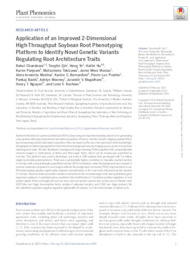Application of an improved 2-dimensional high-throughput soybean root phenotyping platform to identify novel genetic variants regulating root architecture traits.
Application of an improved 2-dimensional high-throughput soybean root phenotyping platform to identify novel genetic variants regulating root architecture traits.
Author(s): CHANDNANI, R.; QIN, T.; YE, H.; HU, H.; PANJVANI, K.; TOKIZAWA, M.; MACIAS, J. M.; MEDINA, A. A.; BERNARDINO, K. C.; PRADIER, P.-L.; BANIK, P.; MOONEY, A.; MAGALHAES, J. V. de; NGUYEN, H. T.; KOCHIAN, L. V.
Summary: Nutrient-efficient root system architecture (RSA) is becoming an important breeding objective for generating crop varieties with improved nutrient and water acquisition efficiency. Genetic variants shaping soybean RSA is key in improving nutrient and water acquisition. Here, we report on the use of an improved 2-dimensional high-throughput root phenotyping platform that minimizes background noise by imaging pouch-grown root systems submerged in water. We also developed a background image cleaning Python pipeline that computationally removes images of small pieces of debris and filter paper fibers, which can be erroneously quantified as root tips. This platform was used to phenotype root traits in 286 soybean lines genotyped with 5.4 million single-nucleotide polymorphisms. There was a substantially higher correlation in manually counted number of root tips with computationally quantified root tips (95% correlation), when the background was cleaned of nonroot materials compared to root images without the background corrected (79%). Improvements in our RSA phenotyping pipeline significantly reduced overestimation of the root traits influenced by the number of root tips. Genome-wide association studies conducted on the root phenotypic data and quantitative gene expression analysis of candidate genes resulted in the identification of 3 putative positive regulators of root system depth, total root length and surface area, and root system volume and surface area of thicker roots (DOF1-like zinc finger transcription factor, protein of unknown function, and C2H2 zinc finger protein). We also identified a putative negative regulator (gibberellin 20 oxidase 3) of the total number of lateral roots.
Publication year: 2023
Types of publication: Journal article
Unit: Embrapa Maize & Sorghum
Keywords: Genética Vegetal, Raiz, Seleção Fenótipa, Soja
Observation
Some of Embrapa's publications are published as ePub files. To read them, use or download one of the following free software options to your computer or mobile device. Android: Google Play Books; IOS: iBooks; Windows and Linux: Calibre.
Access other publications
Access the Agricultural Research Database (BDPA) to consult Embrapa's full library collection and records.
Visit Embrapa Bookstore to purchase books and other publications sold by Embrapa.

